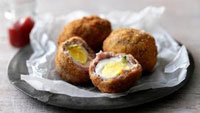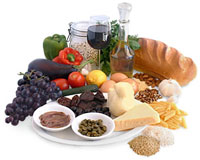AS SUMMER approaches, picnics fast become the dining mode of choice. But in a modern age when you can get almost anything pre-packaged, have we forgotten how to pack a perfect picnic?
 “I think we have lost the art of picnics. The Victorians used to pack the most wonderful picnics.
“I think we have lost the art of picnics. The Victorians used to pack the most wonderful picnics.
“Now we are into fast-food all down the high street, and picking up packaged sandwiches,” says Janet Butler, a course tutor at Bishop Burton College, in Beverley, Yorkshire.
She teaches cooking classes in packing a perfect picnic and posh picnics to inspire people to cook, as the simple picnic has changed since its first incarnation as an elaborate feast.
Gone are the homemade meals and multiple courses, replaced by convenience foods, takeaways, or at the other end of the scale, luxury hampers of goodies prepared by chefs and delicatessens, and delivered to those who don’t need to lift a finger.
Location is paramount, with parks, riversides, hilltops, and beaches all providing glorious picnicking opportunities. But no matter where you choose to dine, what you eat and drink is just as important.
Origins
The earliest picnics in England and France were medieval hunting feasts in the 14th Century, says The Oxford Companion to Food, but the word itself did not come in to common use until 1740.
Picnic, or pique-nique, is of French origin, formed from the words ‘piquer’, the French for “to pick at food”, and ‘nique’, meaning something small, and of no value.
Its meaning has slightly changed over the years.
In the Littre dictionary, it was described as “an informal meal in which everyone pays his share, or brings his own dish”; however, later, the Oxford English Dictionary said it was “An occasion when a packed meal is eaten outdoors, especially during an outing to the countryside.”
Once only reserved for wealthy hunters and country people out on their estates, it was the Victorians who popularised the picnic, and made it commonplace, with writers like Dickens, Trollop and Jane Austen all adopting the convention in their books.
Food writer, Georgina Ingham says the concept of picnicking remains the same, but today, “they are less formal.”
“The Victorian picnic was a way of taking the meal in its entirety outside, whereas the modern picnic is about fuss-free, easy-to-eat food that can be enjoyed whilst in good company, and enjoying the short-lived British summertime,” she says.
Fortnum & Mason’s archivist, Andrea Tanner says eating outdoors was not originally something for the upper classes, but Fortnum’s was at the forefront of the picnic hamper.
“They didn’t start off as picnic hampers; they started off as travellers’ baskets in the 18th Century,” she explains. “There were a lot of coach inns along Piccadilly, and baskets would be given to people to continue their journeys.
“By the early Victorian period, we were producing very large hampers full of raised pies; the Scotch eggs, which we invented in the 1730s; boned and sliced chickens and capons; English cheeses; bread-baked goods; butter wrapped in lettuce leaves to keep it sweet and cool; and very rich fruit cake.
“Originally, servants and coaches used to come in Victorian times at 4am to pick up a picnic hamper for the Epsom Derby; that was a big event for us, and lobster salad was the great luxury. It was half-a-lobster and great quantities of alcohol,” she says.
Variations
Simplicity was not the Victorians’ strong point, as can be seen in the “Bill of fare for a Picnic for Forty Persons” in Mrs Beeton’s Book of Household Management of 1861.
The menu: A joint of cold roast beef; a joint of cold boiled beef; two ribs of lamb, two shoulders of lamb; four roast fowls; two roast ducks; a ham, a tongue, and two veal-and-ham pies; two pigeon pies; six medium-sized lobsters; one piece of collared calf’s head; then salads, biscuits, bread and cheese, and 122 bottles of drink … Plus champagne!
Picnics became more and more elaborate in the 1920s and 1930s.
“In the Edwardian era,” Tanner said, “it was more like having banquets out of doors, and we’d supply everything, including servants and livery.”
“Most of what we sold was made on the premises, in the 1920s; we had a big department for picnic hampers and for motorists, which was the sport of the day, and made up the menus for them, and supplied the little wicker baskets and linen,” she added.
During the yachting festival, Cowes Week on the Isle of Wight, Fortnum’s even had a boat to deliver the picnics to yachts moored in Cowes.
Tanner says the main change since Victorian times is that today, “people don’t have the same number of servants to carry everything around.”
In 1936, Hilda Leyel, of Shripney Manor, Shripney, Sussex wrote the Perfect Picnic.
“The art of arranging cold meals is to choose dishes that are better cold than they would be hot,” she said.
She championed local seasonal ingredients, and recommended dishes like egg mayonnaise on crusty bread, watercress, beetroot and nasturtium salad, and chicken-and-leek pie.
Picnickers still seem to enjoy a taste of nostalgia, and a splash of yesteryear — with pies still a picnic staple.
“Individual items seem perfect picnic food; for example, the Melton Mowbray pork pie,” says Clarissa Dickson-Wright in her book, A History of English Food.
She claims it was “very popular among fox hunters, as it was easy to slip into a pocket.”
But, “there was a time when picnics became a bit sad after World War II, when it was a limp salad, a cheese sandwich, and an apple”, says Tanner.
“Now, it’s all al fresco dining. I like to go to the opera in Holland Park, and you can see the effort people go to: Himalayan or Malvern salt, proper mayonnaise, all fresh, much more of a feast.”
Great British Bake-Off winner and baker, Edd Kimber says he tends to go “for something slightly simpler” and very British.
“I don’t want to spend time in the kitchen; I don’t think you are legally allowed to picnic in this country without scones,” he jokes.
“We do it properly; we take clotted cream and jam, and we always take Pimms along as well.
“Most recently, we decided to also bake scotch eggs, which are simple but tasty. We made four, so they were a lot bigger than normal, but the taste was immeasurably better.
“It doesn’t sound much, but it was a very grown-up picnic, and it was delicious.”
Scotch eggs
Scotch eggs have become the alternative to sandwiches, and are now eaten all year round, but especially in summer, says Neil Chambers from the Handmade Scotch Egg Company.
“They’ve been around a long time, and like pasties and bacon sandwiches, are seen as a classic.
“When we started in 2003, they were totally out of fashion. Over the last four years, they have become mainstream again, and now are back in pubs and restaurants, and, with the Masterchef dish (2013 winner, Natalie Coleman made one as part of her winning dish), are now back in their rightful place,” he says.
His firm produces 54 flavours of scotch eggs in their handmade range, creating about 20,000 a week, and going from a small husband-and-wife team, to a £1M-a- year business with 30 staff.
“Some people like to cut it in half; other people like to cut it into quarters to eat it daintily. Some people like to eat it like an apple, not dainty at all. It’s basic and a comfort food,” he explains.
Along with pork pies and handmade pasta salad, Janet Butler teaches her students to make them too.
“Scotch eggs, people think, are a great mystery, and buy from a supermarket; but once they make their own, they think they are so much better,” she says.
True ‘Brit’ picnic
So, what else should be in a “British” picnic? Homemade sausage rolls for one, says Butler.
“I like the pasty and the cucumber sandwich, quiche, pastries; those are all good old-fashioned picnic foods. You just need those, and not much else,” says Neil Andrews.
Edd Kimber recommends “sticking to the classics.”
“If you are going to bake for a picnic, make it small and easy to transport… A Battenberg (cake) would be perfect, and is another very British thing,” says Edd Kimber.
Pork pies and Scotch eggs also get the nod from Andrea Tanner, but she says “they have to be good quality.”
She says picnic hampers should celebrate seasonality, so “English strawberries, cold asparagus in a vinaigrette, watercress rather than lettuce, if going to have quiche you want a decent one, or a British bacon and egg pie.”
Georgina Ingham says people use too many pre-packaged convenience foods, but she points out artisan produce is readily available and appeals to many.
“The process of selecting food at farmers markets ready to take on a picnic also seems to be increasingly popular,” she says. However, her menu “depends on the situation.”
However, her menu “depends on the situation.”
“Mezze selections such as flatbreads, olives, hummus, and roast ‘veg’ can be great for friends enjoying the summer sun.
“For a romantic time, you can’t beat fresh seafood, prosecco or Champagne and strawberries.
“The key is to take ‘sturdy’ items that won’t bruise or break easily if bumped. One of my favourites is a Mediterranean selection of cheese, hams, olives, salad and artisan breads,” says Ingham.
Such flavours are readily found in gourmet hampers, like those available at Italian restaurant chain, Carluccio’s.
Hampers
Hampers ranging from £25 through to several hundred pounds are a big business for retailers, celebrity chefs and restaurants, who market them for weekends in the park, at outdoor movies, the races, or any number of summer outdoor events.
Each one can be selected to fit a style, taste or cuisine, and only your bank balance is the limit. Fortnum’s, with all its history and experience, caters for the very top end of the market.
“Our picnics are bespoke; people call up and say, ‘I want a picnic hamper,’ and we organise that,” says Andrea Tanner. And in a nod to the Golden Age of the picnic, she adds: “We can even deliver them to St James’s Park, or to Green Park, in all the livery.”
There is even a move to make picnicking “fine dining” once again. Chef Thierry Marx, owner of the Sur Mesure par Thierry Marx restaurant in Paris, which holds two Michelin stars, is putting on what he claims will be the world’s first picnic restaurant in Soho Square later this month: A free lunch for 100 lucky guests.
The Frenchman is embracing an English menu, but picnicking is not just an English thing. The Japanese picnic to admire the blossoming of chrysanthemums or cherry blossoms; the Chinese feast by gravesides to honour ancestors; as do Mexicans on the Day of the Dead.
So perhaps some international inspiration such as sushi, pork buns or soft tacos may spice up your packed lunch.
Whatever you decide to munch on, try and leave as little waste as possible.
For, as Hilda Leyel wrote in 1936: “It is very distressing to see the countryside disfigured sometimes by paper bags and empty bottles.” (BBC)



.jpg)








